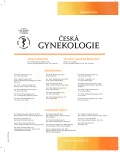Rare forms of feto-fetal transfusion in a clinical practice
Authors:
H. Kováčová 1; D. Matura 1; O. Šimetka 1; J. Pannová 1; P. Delongová 2
Authors‘ workplace:
Gynekologicko-porodnická klinika LF OU a FN, Ostrava, přednosta doc. MUDr. O. Šimetka, Ph. D., MBA
1; Ústav patologie LF OU a FN, Ostrava, přednosta doc. MUDr. J. Dvořáčková, Ph. D.
2
Published in:
Ceska Gynekol 2017; 82(3): 190-196
Overview
Objective:
To analyze monochorionic twin pregnancies with twin anemia polycythemia sequence (TAPS) and acute peripartal twin to twin syndrome (aTTTS), to compare their prenatal management and perinatal outcome.
Methods:
Retrospective analysis of monochorionic biamniotic twin pregnancies without signs of chronic TTTS within a period 10/2010 to 10/2013. Further selection of cases with haemoglobin difference in neonates greater than 50 g/l was made, type of feto-fetal haemorrhage was determined and their prenatal and postnatal characteristics were described.
Results:
Based on the criteria described above we selected four cases out of 55 monochorionic pregnancies. One case of prenatally diagnosed spontaneous TAPS which fulfilled all the diagnostic criteria with typical angioarchitecture inclusive, one case of spontaneous TAPS diagnosed postnatally, a case of postlaser TAPS with a spontaneous resolution and one unusual case of feto-fetal haemorrhage which does not fully meet criteria of TAPS or aTTTS. All the pregnancies were delivered by caesarean section. All the anaemic neonates required blood transfusion postpartum and two of the polycythemic neonates needed partial exsanguination.
Conclusion:
Rare forms of feto-fetal transfusion syndrome form a heterogenous group and it may be difficult to distinguish between TAPS and aTTTS in certain cases. A recommendation for a management of TAPS cases was published in recent literature. However, correct interpretation of dopplerometric measurments belongs to the hands of experienced ultrasonographers in perinatal centers.
Keywords:
monochorionic pregnancy, anaemia, polycythemia, feto-fetal transfusion, twin to twin syndrome
Sources
1. Berghella, V., Kaufmann, M. Natural history of twin-twin transfusion syndrome. J Reprod Med, 2001, 46, 5, p. 480–484.
2. Groussolles, M., Sartor, A., Connan, L., Vayssière, C. Evolution of middle cerebral artery peak systolic velocity after a successful laser procedure for iatrogenic twin anemia-polycythemia sequence. Ultrasound Obstet Gynecol, 2012, 39, 3, p. 354–356.
3. Gucciardo, L., Lewi, L., Vaast, P., et al. Twin anemia polycythemia sequence from a prenatal perspective. Prenat Diagn, 2010, 30, p. 438–442.
4. Lewi, L., Jani, J., Blickstein, I., et al. The outcome of monochorionic diamniotic twin gestations in the era of invasive fetal therapy: a prospective cohort study. Am J Obstet Gynecol, 2008, 199, 5, p. 514.e1–8.
5. Lopriore, E., Sueters, M., Middeldorp, JM., et al. Hemoglobin differences at birth in monochorionic twins without chronic twin-to-twin transfusion syndrome. Prenat Diagn, 2005, 25, p. 844–850.
6. Lopriore, E., Middeldorp, JM., Oepkes, D., et al. Twin anemia-polycythemia sequence in two monochorionic twin pairs without oligo-polyhydramnios sequence. Placenta, 2007, 28, 1, p. 47–51.
7. Lopriore, E., Oepkes, D. Fetal and neonatal haematological complications in monochorionic twins. Semin Fetal Neonatal Med, 2008, 13, 4, p. 231–238.
8. Lopriore, E., Deprest, J., Slaghekke, F., et al. Placental characteristics in monochorionic twins with and without twin anemia-polycythemia sequence. Obstet Gynecol, 2008, 112, 4, p. 753–758.
9. Lopriore, E., Slaghekke, F., Oepkes, D., et al. Hematological characteristics in neonates with twin anemia-polycythemia sequence (TAPS). Prenat Diagn, 2010, 30, p. 251–255.
10. Lopriore, E., Holtkamp, N., Sueters, M., et al. Acute peripartum twin-twin transfusion syndrome: Incidence, risk factors, placental characteristics and neonatal outcome. J Obstet Gynaecol Res, 2013, 7, p. 22.
11. Lopriore, E., Slaghekke, F., Kersbergen, KJ., et al. Severe cerebral injury in a recipient with twin anemia-polycythemia sequence. Ultrasound Obstet Gynecol, 2013, 41, 6, p. 702–706.
12. Lopriore, E., Middeldorp, JM., Sueters, M., et al. Twin to twin transfusion syndrome: from placental anastomoses to long-term neurodevelopmental outcome. Curr pediatric Rev, 2005, 1, p. 191–203.
13. Machin, GA. Vascular anatomy of monochorionic twin placentas. Multiple Pregnancy, 2010, p. 193–199.
14. Robyr, R., Lewi, L., Salomon, LJ., et al. Prevalence and management of late fetal complications following successful selective laser coagulation of chorionic plate anastomoses in twin-to-twin transfusion syndrome. Am J Obstet Gynecol, 2006, 194, 3, p. 796–803.
15. Slaghekke, F., Kist, WJ., Oepkes, D., et al. Twin anemia-polycythemia sequence: diagnostic criteria, classification, perinatal management and outcome. Fetal Diagn Ther, 2010, 27, p. 181–190.
16. Slaghekke, F., Pasman, S., Veujoz, M., et al. Middle cerebral artery peak systolic velocity to predict fetal hemoglobin levels in twin anemia-polycythemia sequence. Ultrasound Obstet Gynecol, 2015, 46, 4, p. 432–436.
17. Slaghekke, F., Favre, R., Peeters, SH., et al. Laser surgery as a management option for twin anemia-polycythemia sequence. Ultrasound Obstet Gynecol, 2014, 44, 3, p. 304–310.
18. Ústav zdravotnický informací a statistiky ČR. Rodička a novorozenec 2013. [online]. 30.11.2013 [cit. 2016-11-30]. Dostupné z: http://www.uzis.cz/katalog/zdravotnicka-statistika/rodicka-novorozenec.
19. Vaillant, M., Chantepie, A., Casasoprana, A., et al. Transient hypertrophic cardiomyopathy in neonates after acute fetal distress. Pediatr Cardiol, 1997, 18, 1, p. 52–56.
Labels
Paediatric gynaecology Gynaecology and obstetrics Reproduction medicineArticle was published in
Czech Gynaecology

2017 Issue 3
Most read in this issue
- Complications tension-free vaginal tape surgery
- Current FIGO staging classification for cancer of ovary, fallopian tube and peritoneum
- Hirsutism
- Retrospective analysis of monochorionic twin pregnancies born in the Institute for the Care of Mother and Child between 2012–2015
